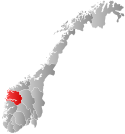Selje Municipality
Selje kommune | |
|---|---|
| Selløe herred (historic name) | |
 View of the island of Barmen in Selje | |
|
| |
 Sogn og Fjordane within Norway | |
 Selje within Sogn og Fjordane | |
| Coordinates: 62°08′14″N 05°13′23″E / 62.13722°N 5.22306°E | |
| Country | Norway |
| County | Sogn og Fjordane |
| District | Nordfjord |
| Established | 1 Jan 1838 |
| • Created as | Formannskapsdistrikt |
| Disestablished | 1 Jan 2020 |
| • Succeeded by | Stad Municipality |
| Administrative centre | Selje |
| Government | |
| • Mayor (2015-2019) | Stein Robert Osdal (KrF) |
| Area (upon dissolution) | |
| • Total | 226.12 km2 (87.31 sq mi) |
| • Land | 219.88 km2 (84.90 sq mi) |
| • Water | 6.24 km2 (2.41 sq mi) 2.8% |
| • Rank | #317 in Norway |
| Population (2018) | |
| • Total | 2,757 |
| • Rank | #279 in Norway |
| • Density | 12.5/km2 (32/sq mi) |
| • Change (10 years) | |
| Demonym | Seljeværing[1] |
| Official language | |
| • Norwegian form | Nynorsk |
| Time zone | UTC+01:00 (CET) |
| • Summer (DST) | UTC+02:00 (CEST) |
| ISO 3166 code | NO-1441[3] |
Selje is a former municipality in the old Sogn og Fjordane county, Norway and was located in the traditional district of Nordfjord. The village of Selje was the administrative center this municipality. and neighborhoods in the municipality included Barmen, Ervik, Flatraket, Hoddevik, Hoddevika, Håvik, and Leikanger. On 1 January 2020 the municipality became part of the new Stad Municipality in the newly formed Vestland county.
Selje municipality had been located at the northwesternmost part of Sogn og Fjordane county. Most of the municipality was located on and around the Stadlandet peninsula as well as some small surrounding islands such as Selja and Barmøya.
At the time of its dissolution in 2020, the 226-square-kilometre (87 sq mi) municipality was the 317th largest by area out of the 422 municipalities in Norway. Selje was the 279th most populous municipality in Norway with a population of 2,757. Its population density was 12.5 inhabitants per square kilometre (32/sq mi) and its population had decreased by 4% over the prior decade.[4][5]
Selje was one of the first three Episcopal sees in Norway (Oslo, Nidaros, and Selje). After the diocese was moved to Bergen, monks took over the church in Selje, which was later destroyed by pirates in 1536. The municipality of Selje was also home to the Selje Abbey, a former Benedictine monastery located on the island of Selja. Ruins of the abbey and church can still be seen on the island.[6]
- ^ "Navn på steder og personer: Innbyggjarnamn" (in Norwegian). Språkrådet.
- ^ "Forskrift om målvedtak i kommunar og fylkeskommunar" (in Norwegian). Lovdata.no.
- ^ Bolstad, Erik; Thorsnæs, Geir, eds. (26 January 2023). "Kommunenummer". Store norske leksikon (in Norwegian). Kunnskapsforlaget.
- ^ Statistisk sentralbyrå (2018). "Table: 06913: Population 1 January and population changes during the calendar year (M)" (in Norwegian). Retrieved 5 October 2019.
- ^ Statistisk sentralbyrå. "09280: Area of land and fresh water (km²) (M)" (in Norwegian). Retrieved 5 October 2019.
- ^ Cite error: The named reference
Gowas invoked but never defined (see the help page).

